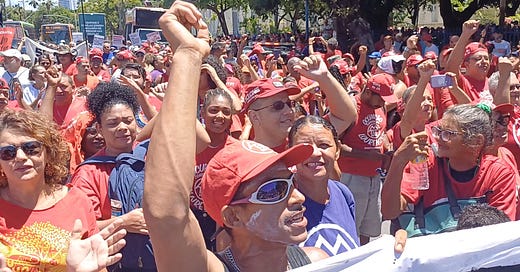On March 30, social movement activists and union workers took to the streets in eight of Brazil’s largest cities to protest a far-right coalition in Congress attempting to introduce a bill that would grant amnesty to hundreds of people indicted for alleged involvement in the January 2023 military coup attempt. Among them is former President Jair Bolsonaro, whom the Supreme Court recently declared a defendant in five criminal cases, including charges of forming an armed criminal organization and attempting to stage a coup d’état.
The protests were coordinated by two major working-class fronts—Frente Brasil Popular and Povo Sem Medo—formed in 2015 by networks of labor unions, student associations, and social movements to resist the impending coup against Dilma Rousseff. These groups later became key forces opposing Lula’s political imprisonment and the abuses of the Bolsonaro government.
The demonstrations were not expected to be massive. Two weeks ago, Bolsonaro predicted that "1 million" people would attend his pro-amnesty rally on Rio’s Copacabana beach and in other cities, but turnout fell far short, with an estimated 18,300 in Rio and crowds numbering in the hundreds elsewhere. Before Sunday’s protests, Guilherme Boulos projected a crowd of 20,000 in São Paulo. While exact numbers are debated, aerial photos and drone footage suggest a turnout comparable to Bolsonaro’s Copacabana rally—but unlike the far-right’s events, the organized left mobilized thousands in multiple cities, including Belo Horizonte and Recife, where I covered the protest for TeleSur.
Photos and drone footage from Sunday’s protest in S. Paulo suggest it was larger than the estimated 6,500 people, reported in the mainstream media
Regardless of crowd size, Sunday’s protests demonstrated that Brazil’s working-class left retains the ability to mobilize people from the ground up, simultaneously across multiple cities, with minimal funding. This contrasts sharply with the far right’s top-down approach, which relies on heavy business-sector financing to bus in participants from the countryside.
On the left, labor unions often lend buses to social movements, to help residents from land occupations attend protests, often providing bottled water and sandwiches, but it’s a far cry from the videos which have surfaced on the internet of Bolsonaro supporters walking down bus aisles handing out R$100 bills to “protesters”, or the millions donated by agribusiness barons to maintain the coup encampments in front of military barracks in 2022. . In Recife, I saw only one such bus, carrying a group from an MTST settlement, in a crowd of roughly 5,000. With finances tight at the month’s end, I took a city bus to and from the protest, as did many others. The demonstration’s demographics were overwhelmingly working-class.
In conclusion, while Sunday’s protests were not on the scale of a 2013-style color revolution, the organized left proved that its networks remain intact. If the amnesty bill gains traction, these structures can facilitate much larger mobilizations.
Below is my TeleSur news story on the anti-amnesty protests.





